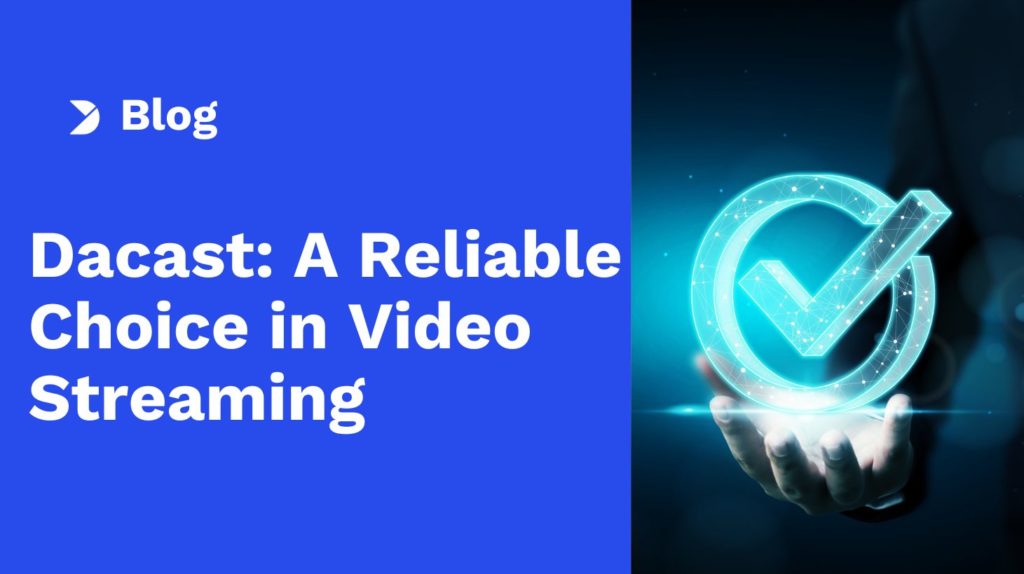Vimeo, Brightcove, StreamYard: Why Dacast Remains the Most Reliable Alternative
In the past 18 months, Bending Spoons has made a series of high-profile moves in online video—agreeing to acquire StreamYard (2024), closing its acquisition of Brightcove (February 2025), and announcing a definitive agreement to acquire Vimeo (September 2025). These developments matter for broadcasters, OTT providers, and enterprises that depend on stable video infrastructure. Mergers and acquisitions always raise questions for users about pricing, support, and continuity. This article lays out the practical risks to evaluate and why Dacast continues to be chosen as the secure, independent choice for live streaming and video hosting.
Table of Contents
- The Acquisitions: Facts and Context
- Questions Broadcasters Should Ask
- Evaluating Your Video Platform Strategy
- Dacast as a Reliable, Independent Alternative
- Practical Examples
- Migration Made Easy
- Conclusion
The Acquisitions: Facts and Context

- StreamYard: Bending Spoons confirmed an agreement to acquire StreamYard Top Corp (owner of StreamYard, Streamable, Superwave) in April 2024.
- Brightcove: Brightcove entered a definitive agreement to be acquired in November 2024 and announced deal close on February 4, 2025; the company is now privately held.
- Vimeo: On September 10, 2025, Vimeo said it will be acquired by Bending Spoons in an all-cash deal valued around $1.38B (pending customary approvals), taking the company private.
These deals align with Bending Spoons’ broader strategy to expand its portfolio of software and media tools. Previous acquisitions have also involved cost-optimization measures – such as layoffs at WeTransfer, and more recently nearly 200 Brightcove employees were let go in March 2025 following the acquisition. For teams evaluating potential long-term platform risks, such restructuring is an important consideration.
Questions Broadcasters Should Ask
Periods of M&A don’t automatically mean disruption; many acquisitions improve products. Still, smart teams pressure-test their dependencies. Use questions like these to guide internal reviews—including emerging concerns about whether customer content could be used for AI model training, as raised after Bending Spoons’ WeTransfer acquisition
To help internal teams systematically evaluate these risks, here are key questions to guide your platform review:
- Pricing & Packaging
- Could plans, overage tiers, or add-on pricing change for my Vimeo or Brightcove contracts?
- How will any changes impact forecasted viewer-hours, egress, and storage costs for the next 12–24 months?
- Support & SLAs
- Will support models, response times, or escalation paths change?
- Are my SLA terms (uptime, incident response) contractually preserved through ownership changes?
- Roadmap & Integrations
- Will player SDKs, APIs, or analytics endpoints be consolidated or renamed?
- Are features I rely on (e.g., S3/Blob storage bridges, SSO/SAML, VAST/VMAP ad calls, webhooks) on a stable roadmap with public timelines?
- Data Ownership & Governance
- Where will content and logs live post-closing?
- Will data retention policies or DPA/processing locations shift?
- Change Management
- What is the vendor’s communication plan for breaking changes?
- Is there a published migration path if product lines are unified?
Why teams are asking now: In user communities, acquisitions often trigger debate about future pricing and feature continuity (for example, the Evernote community discussed pricing and plan changes after Bending Spoons’ takeover—useful as a pattern, not a prediction for video platforms).
In practice, these risks can translate into tangible challenges for teams relying on these platforms. Pricing changes or new overage policies may increase operational costs unexpectedly, delayed or altered support processes can affect live event reliability, and shifts in feature roadmaps or API endpoints may require additional engineering resources to maintain integrations. Data governance changes or platform migrations could also create compliance or workflow disruptions. For teams seeking stability and predictability in their video operations, considering an independent platform like Dacast—where roadmap, support, and pricing are transparent—can provide peace of mind and reduce exposure to such uncertainties.
Evaluating Your Video Platform Strategy

Commercial & Risk
- Map your total cost of ownership (hosting, delivery, storage, DVR, DRM, support) for 12–24 months.
- Confirm contract assignment clauses and whether SLAs survive change of control.
Product & Delivery
- Validate ABR ladders, ingest→playback protocol mix (RTMP/SRT ingest, HLS/DASH playback), and player SDK coverage across web, mobile, and CTV.
- Check ad delivery (VAST/VMAP), paywall/subscriptions/PPV, and any SSA/CSA ad integrations you depend on.
Security & Compliance
- Ensure DRM (e.g., Widevine/FairPlay/PlayReady), tokenized playback, and IP/geo restrictions still meet your policy.
- Review PII handling and audit logs for enterprise governance.
Operations
- Confirm 24/7 support availability, incident communication, and runbooks.
- Ask for clear roadmap transparency: what’s changing in the next 2–3 quarters?
Market Trend Context (to brief leadership):
OTT and streaming continue to grow and professionalize—even as models evolve. PwC projects combined OTT + Pay TV consumer spend to rise from $291.3B (2024) to $318.5B (2029), with OTT revenues overtaking pay TV by 2027. Planning with that horizon helps justify resilient, multi-year platform choices.
Dacast as a Reliable, Independent Alternative
If you’re benchmarking a Vimeo alternative, Brightcove alternative, or StreamYard alternative, the most common reasons teams shortlist Dacast include:
- Independence & Focus
Dacast remains independent, with a single focus: professional live streaming and reliable video hosting for businesses. That independence translates into predictable roadmap priorities and transparent communication. - Support & Customer Success
Dacast provides dedicated Customer Success managers and 24/7 support to ensure smooth operations. Teams benefit from proactive guidance, onboarding assistance, and personalized help to quickly resolve issues-whether it’s a live event, VOD upload, or integration setup. - Enterprise-grade reliability
Mature ingest (e.g., RTMP), modern playback (HTML5 HLS with ABR), CDN delivery, and a track record powering live events, education, corporate comms, sports, and worship at scale. - Monetization & Control
Built-in paywall for subscriptions, PPV, bundles, plus VAST/VMAP ad support for hybrid AVOD/SVOD strategies—so you can evolve your revenue mix without re-platforming. - White-label & Brand Ownership
Fully branded player, domains, and embed flows—keep your brand front and center. - APIs & Workflows
Comprehensive REST APIs, webhooks, and integrations to automate upload/encode/publish pipelines, synchronize entitlements, and feed BI/analytics. - Transparent Pricing & Clear SLAs
Straightforward plans, predictable overage logic, and contractual SLAs—so finance and ops can forecast with confidence.
Bottom line: If your board or leadership asks for a contingency plan in light of recent acquisitions, Dacast gives you a credible, low-risk path—without forcing you to compromise on features or support.
Practical Examples
- Global town hall with 50K viewers: Use RTMP ingest → HLS playback with a conservative ABR ladder, tokenized playback, and geo/IP controls. Keep a warm-standby encoder and multi-origin configuration for resilience.
- Sports league with hybrid monetization: Combine pay-per-game PPV with midroll ad breaks via VAST/VMAP. Feed QoE KPIs (startup time, rebuffer ratio, aggregate bitrates) to your data warehouse.
- Corporate learning: Use categories and entitlements, SSO/SAML for user governance, and automatic captioning for accessibility and search.
Migration Made Easy
Migrating to Dacast is straightforward—whether you’re moving a few videos or an entire enterprise library.
Here are the main options available:
- Web upload (ideal for small libraries) – Drag and drop files directly into your Dacast dashboard.
- Bulk upload from cloud storage – Import your content quickly from Amazon S3 or Google Drive.
- API-based migration (recommended for enterprises) – Use Dacast’s RESTful API to automate upload and content management at scale.
Tip: For smoother transfers, upload in smaller batches (10–20 files at a time) to avoid network interruptions.
For full instructions, visit our Knowledge Base migration guide,
Conclusion
Acquisitions can be positive. They can also introduce uncertainty in pricing, support processes, feature roadmaps, and integration stability. The right response isn’t panic—it’s preparation. Take this moment to re-validate your requirements, re-negotiate what matters, and identify a dependable alternative. If you need a reliable video hosting partner that’s independent, transparent, and enterprise-ready, put Dacast on your shortlist.
Curious to explore a platform built with both security and scalability in mind? Try Dacast free for 14 days – no credit card required. Experience our full suite of secure streaming features and see what it can do for your team.
Want more exclusive tips and insider updates on enterprise streaming? Join our LinkedIn community, a space for professionals to share knowledge and stay ahead in the video space.
As always, thanks for reading. Here’s to smarter, safer internal communications. And if you need help getting started, don’t hesitate to reach out. We’re here to help.
 Stream
Stream Connect
Connect Manage
Manage Measure
Measure Events
Events Business
Business Organizations
Organizations Entertainment and Media
Entertainment and Media API
API Tools
Tools Learning Center
Learning Center Support
Support Support Articles
Support Articles